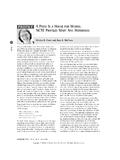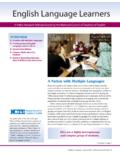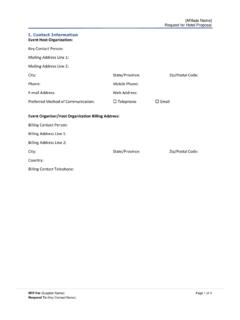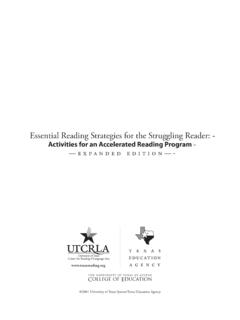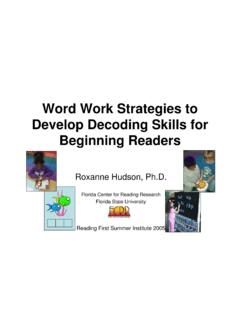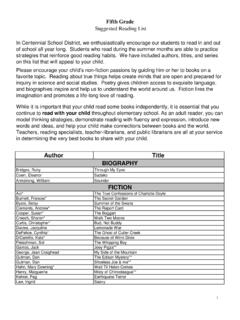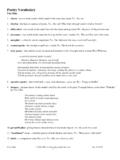Transcription of Features of Literacy Programs - NCTE
1 Features of Literacy Programs : A Decision-Making Matrix Prepared by the Commission on reading National Council of Teachers of English Purpose The Commission on reading of the National Council of Teachers of English regularly undertakes projects to broaden discussion of important Literacy issues and to provide support for teachers as they make informed instructional decisions. Commission members developed the matrix that follows in response to requests from NCTE members for sound, standards-aligned criteria to apply as they select program materials or design local Programs of instruction in reading . It is intended to be used as part of professional discussion among colleagues.
2 Model The model on which the matrix is based is aligned with the position statement, "On reading , Learning to Read, and Effective reading Instruction: An Overview of What We Know and How We Know It" ( ), developed by NCTE's Commission on reading . reading is a complex, purposeful, social, and cognitive process in which readers simultaneously use their knowledge of spoken and written language, their knowledge of the topic of the text, and their knowledge of their culture to construct meaning. Effective reading instruction is grounded in a professional knowledge of how readers make sense of print and how students learn. All instruction is based on a careful observation of learners' reading to determine appropriate instruction.
3 Users The matrix is intended as a discussion and decision-making tool for teachers and curriculum developers working together to select instructional materials. Educators do this based on their understandings of the nature and uses of Literacy and their beliefs about how Literacy is developed. The matrix may be found at the NCTE Web site: Matrix Features The matrix offers categorized Features for teachers to consider in making local decisions about appropriate materials and goals for Literacy instruction. Blank rows are provided for additional Features users find relevant. Instructional emphases will vary depending on students age and proficiency in reading and writing.
4 For example, the early Features listed under word recognition and word study will be most applicable to elementary Programs . These Features are ranked by the NCTE Commission on reading as (4) essential , (3) important, (2) less important, (1) not important for an effective program of Literacy instruction. Decisions about the relative importance of various Features are based on published research and professional resources. However, each group using the matrix should determine its own rankings by considering local needs, standards, and definitions of reading . Furthermore, the Commission emphasizes that numeric evaluation of program Features is less important than the conversations prompted by the use of the matrix.
5 Matrix Use 1) In Column 2 on the matrix, rate each feature in terms of its importance (1-4) for an effective Literacy program. 1 2) For each Literacy program under consideration (whether commercially or locally designed), mark each feature to the degree of its presence in the program. Use H to indicate high degree/presence in significant amount, M to indicate medium degree/presence in some amount, and L to indicate low degree/presence in little or no amount. A desirable program will be one in which Features seen as essential or important are evident to a high degree.
6 Educators may wish to add other Features and compare the ones they rank highly (3-4) with those given high rankings in the matrix designed by the Commission. ** You might find it useful to complete the following two statements before using the matrix and starting your conversations. 1) reading is: _____. 2) reading instruction should be: _____. 2 Program Name _____ INTENDED AUDIENCE (check all that apply) Primary Intermediate Middle School High School English Language Learners (ELL)
7 Native English Speakers Students requiring reading intervention NCTE Commission on reading indicates (4) as essential , (3) as important, (2) as less important, or (1) as not an important feature for an effective Literacy program. Decisions about the relative importance of various Features are based on published research and professional resources. Rate H to indicate high degree/presence, M to indicate medium degree/presence, L to indicate low degree/presence in each reviewed program. A desirable program will be one in which Features seen as essential or important are seen in a high degree. Degree of Presence The "1" column shows NCTE's rating of program Features .
8 The "2" column is for your own rating of the Features . 1 2 H M L MEDIA/TOOLS Books
9 Authentic connected texts, complete & unabridged 4 Predictable texts 4 Decodable texts 1 Abridged texts 2 Skills-based texts 1 Leveled texts 2 Non-fiction texts 4 Classroom libraries 4 Controlled vocabulary 1 Original illustrations 4 Publisher-substituted illustrations 1 Videotapes 2
10 Internet 2 Computer software 3 Audiotapes 3

